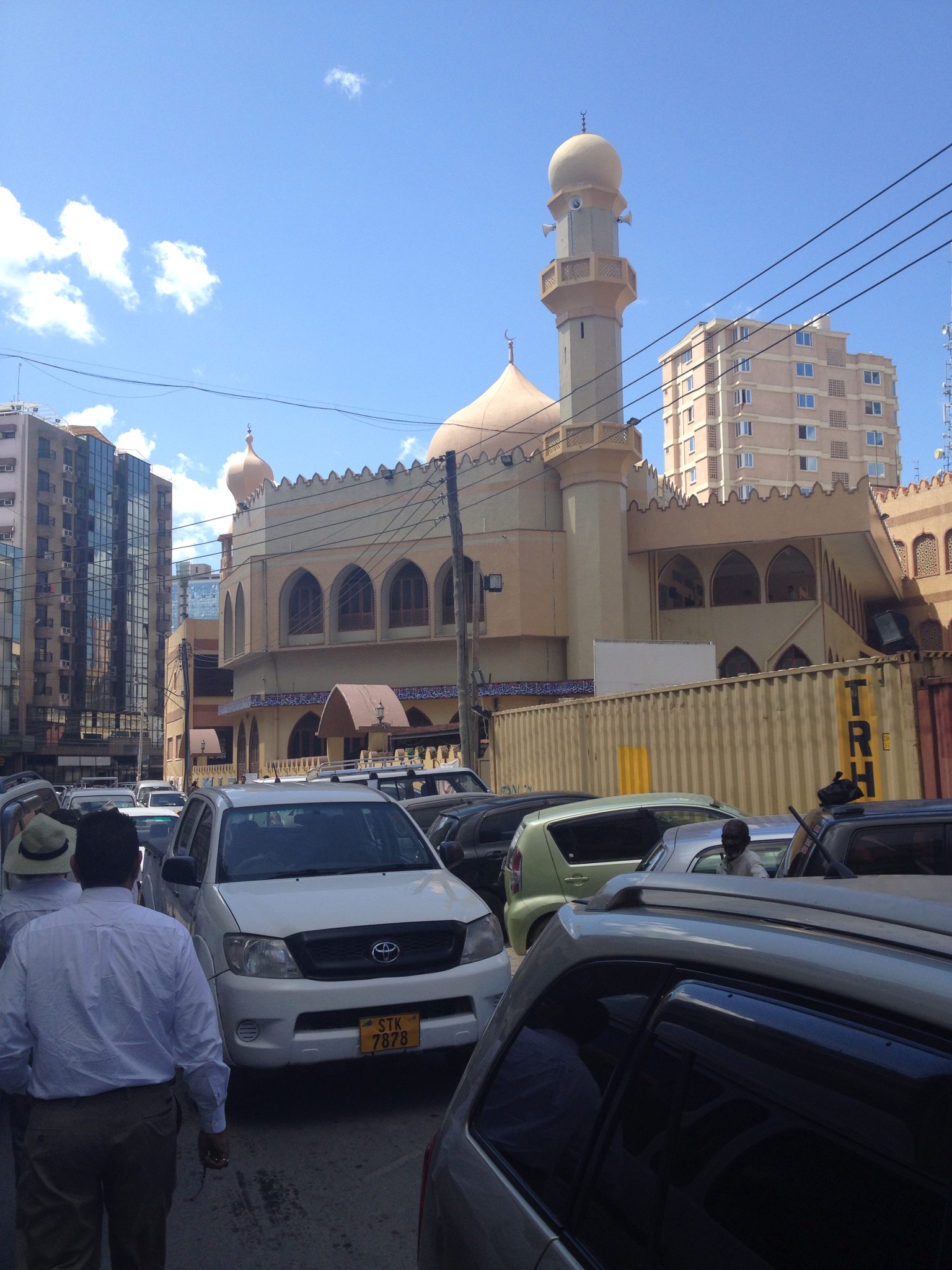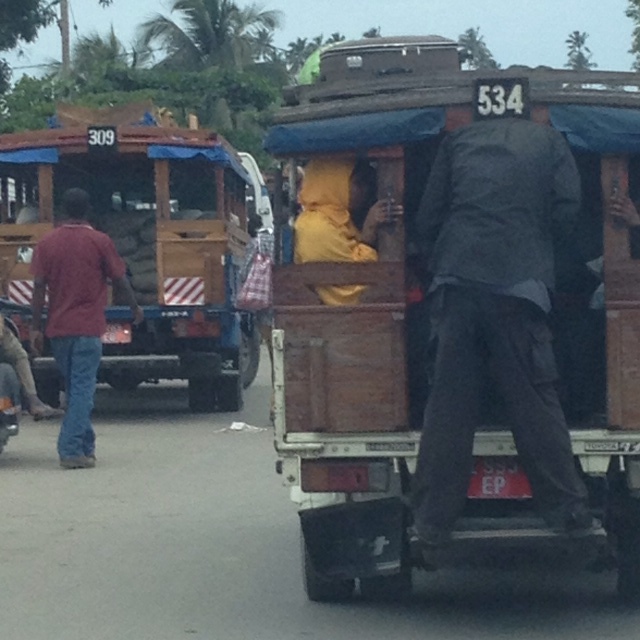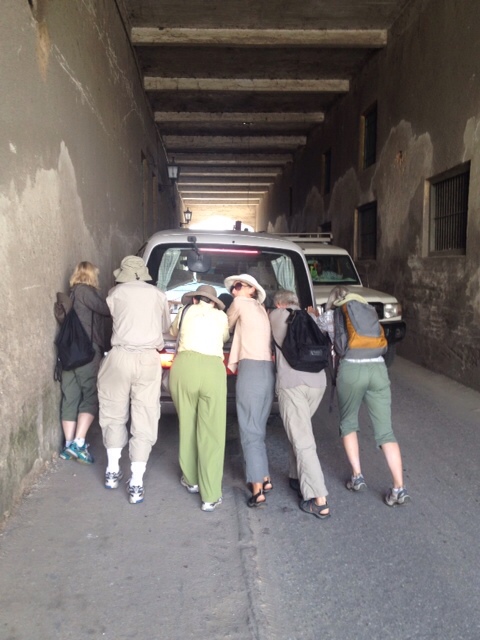
A predominantly Muslim city, this mosque near our hotel issues calls to prayer 5 times a day (including around 6 AM)
We took off shortly after sunrise and 1:45 hours later cruised up to ZanzibarTown dock. We deboarded, and an un-refereed scramble to reclaim our luggage ensued before we entered the terminal house to an even larger scrum of people. Even though Zanzibar is part of Tanzania, it retains a measure of independence which includes, apparently, “immigration” contol.
After a passport and visa review, Jo worked her way through a crowd of taxi-drivers eager for our business to find the van and driver sent by Casa del Mar Jambiani to pick us up. Pre-arranged transport by Jo was one of our better moves!
The ride out of town was, in one word, “hairy.” Besides driving on the left side of the road, British-style, our driver constantly dodged broken pavement, walkers, bicycles, motorbikes, cars, trucks and brahma cows. A horn toot appears to mean “Get outta my way, I’m coming through whether you like it or not!” Round-abouts are contests of will, or maybe a game played by rules unknown to foreigners. Note to self: NEVER ride a bike in Zanzibar! In fact, don’t drive a car, either.
An hour and a half later, our driver turned off the main road and waited for a gate to open. Then we pulled into Casa del Mar Jambiani, a little oasis on the ocean that we would call home for the next 5 days. It took several deep breaths, a nap, a few laughs and a beer to re-establish a travel chi. After busy Dar and a chaotic day of travel, Casa del Mar was just what we needed.
Sunday: We drowsed in bed til 8, then hustled off to breakfast. Danielle, Casa del Mar hostess, had arranged a snorkel adventure for four of us and the boat would come by at 9:30 AM. The reef that protects Zanzibar lies about a mile off shore, with a long sandy flats between it and shore. When the tide is out, the flats are mostly exposed sand; at high tide,they're covered with a few feet of water and strong wave action. We had until 1 PM before the tide would come in.
When Joe & Beth and Betsy & I arrived at the beach, Hajddi, our guide, was waiting for us. We walked about 1/4 mi. over the sandy flats to reach his boat, which was moored in shallow water. Hajddi is 32 years old, from Jambiani, with 2 children, operating his family's boat. Like many of the local craft, it is a dhow–a narrow wooden boat with outriggers and a mountable sail. He had a helper, also named Hajddi (“Hajddi 2”), to pole the dhow out to deeper water and help raise the mast and sail.
Everything about Haddji's dhow is local, employing native technology. It is made on Zanzibar from mango tree; it is joined with handcut mortise & tenon joints; the outriggers (also mango wood) are attached to horizontal poles that are themselves lashed with rope; the mast is bamboo, the sail lightweight canvas. The mast never actually seats into the boat itself–it is held aloft with a rope, while the bottom simply braces against a vertical strut anchored into the boat. If the sail fills with side wind that threatens to tip over the dhow, Hajddi controls the rudder while Hajddi 2 jumps onto the opposite outrigger and leans outward, bracing with a rope, until the dhow levels out.
Only Westerners corn-raised on cars, computers and air conditioning would be amazed by such elemental technology–hey, that describes us. It was a great ride, and we jumped at the chance to grab the rope and help hoist the heavy mast and sail. After 20 min. we could see large waves breaking on the reef edge 1/4 mile ahead, so we anchored, put on our fins and masks, and dove into the water. The snorkeling was fine, with clear water, bright orange starfish, large serrated clams and a few fish species. No, it didn't compare to Roatan or Hawaii for plentiful brightly colored fish. But those places didn't have a dhow to deliver us to the reef!
Casa del Mar overlooks the Indian Ocean from a platform of sand protected by a concrete seawall. At low tide, exposed sandy flats and tidal pools stretch for hundreds of yards to the ocean's edge. At high tide, waves pound the seawall relentlessly and frequently splash up into the courtyard. Houses and small resorts up and down the coast are simillarly sited, though many have bamboo posts, or wicket fences, or just a sand bank in lieu of a seawall. How long this can last is anyone's guess. According to a ranger at Jozani Forest, the sea level in estuaries has risen about a meter in the last 40 years, and the Indian Ocean keeps rising.
The setting has an idyllic effect on visitors as the wave's rhythm is like a background soundtrack for meditation or yoga. When the tide's out, Casa del Mar is soothed with the sound of birds and breezes in the coconut palms and mkungu trees (thick, big-leafed trees similar to magnolias). Even the mosquitoes leave us alone.
We're here, apparently, at the best time of year–“winter” 6 degrees south of the equator–as the daily high temps don't leave the 80's and cool sea breezes are steady. Daniela, our hostess, says she tells her friends NOT to come in February and March because of the heat–there is no air-conditioning–, and Casa del Mar is closed in April and May during the rainy season.
But now, the staff is always smiling and everyone seems content and happy. Is it an illusion created for guests? Perhaps. It's an effective illusion. The testimony on the internet suggests this part of Zanzibar is home to happy people, even if the average daily income is $1/day. Hakuna matata is the national motto, and that was the case long before Disney popularized it.
Everything is not perfect. The wifi sucks and quickly bogs down when more than a couple users sign on. It make downloading photos and uploading a blog post difficult. The coffee is not what one would expect in one of the great coffee-producing areas of the world. The food is average, which probably makes it above-average for this strip of coast.
Those are paltry details given the low-key vibe and natural beauty of the Zanzibar coast. Around us local women gather seaweed on the sandy flats at low-tide and men wait by their dhows for the tide to come in. Small clusters of kids in Islamic dress skip home from school. Life goes on. Hakuna mutata!

Open-sided daladalas are everywhere on the road into Zanzibar Town. They are THE mass transit solution for Zanzibar, privately owned, largely unregulated and cheap. We traveled in air-conditioned, private van comfort, at least until….
StoneTown is on most tourists must-see list so today it showed up on ours. Well, actually our itinerary said we were going on a Spice Tour, and that was our plan until our driver, who didn’t speak English, drove us to StoneTown. Hakuna matata!

….we entered the tunnel entrance to StoneTown and our van died. Then we did what any good rescue team would do in the narrow tunnel until…..
Driving into Zanzibar Town (StoneTown is the historic city center of Zanzibar Town) is never easy given the crowded, chaotic streets, but this van ride had an exclamation point when we entered the narrow tunnel that defines the entry to StoneTown and our engine died. It wouldn’t restart because the battery was dead. The photos tell the the rest of the story.